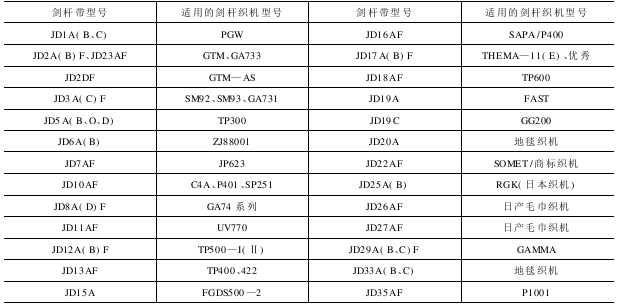1. Comparison of rapier belt product models and loom models (Table 14-1) Table 14-1 Comparison table of rapier belt models and applicable rapier loom models
2. Appearance requirements (1) The product surface should be smooth and smooth, without debonding, delamination, wrinkles and concave Defects such as pits. (2) The surface roughness of the bottom surface of the rapier belt and both sides of the belt width is Ral.6, the surface roughness around the perforation is Ra3.2, and no machining traces are allowed on the wear-resistant layer surface (non-metal processing surface roughness grade is based on the metal surface The roughness grade is equivalent to one level lower. That is: non-metal Rat.16 is equivalent to metal Ra3.2). (3) Straightness and warpage ≤3mm. 3. Product technical performance The product technical performance is shown in Table 14-2. 

4. Form and position tolerance (1) The straightness tolerance of both sides of the bandwidth is 0.20/1000mm. (2) The symmetry tolerance of the center of the perforation relative to the center line of the sword belt is 0.20mm. 5. Main matching dimensions (Table 14-3)
6. Service life of the sword The average service life of the rod belt is more than 5.8×107 times. 7. Inspection rules 1. Batch grouping rules Rapier belt products are inspected in batches. Products using the same raw materials, the same formula, the same process, and produced on the same day are designated as a batch. 2. Inspection items The inspection items for rapier belts are as specified in Table 14-4. 
 3. The sampling inspection method for production inspection should be formulated in accordance with the requirements of GB/T2828-1987 that the general inspection level is IT and the qualified quality level (AQL) is 4.0. 4. Factory inspection Before each batch of rapier belt products leaves the factory, they should be inspected in accordance with the factory inspection items and sampling quantities specified in Table 14-4. If one of the inspection results does not meet the requirements, it will be judged as a substandard product and the product will be scrapped. deal with. 5. Type inspection Rapier belt products should undergo type inspection under the following circumstances: (1) During normal production, it should be conducted at least once per quarter. (2) When there are major changes in raw materials, processes, structures, etc. (3) When the model has been out of production for more than 1 year and resumes production. (4) When the product has batch quality problems. (5) When the customer requests inspection. (6) When the national quality supervision department puts forward inspection requirements. Each type inspection shall include all items of mechanical properties (including tensile properties and bending properties), physical properties and chemical properties specified in Table 14-2. When any test data is unqualified, double samples should be taken from the same batch of products for re-inspection. If the re-inspection test data is qualified, the batch of products is deemed to be qualified; if the re-inspection still fails, the batch of products will be scrapped; at the same time, measures should be taken to address the reasons for the failure to avoid this situation from happening again. 8. Labeling, storage, packaging and transportation Each rapier belt should be printed with the trademark and batch number identification on the fixed part of the belt body. Also, rapier straps should be stored indoors under natural conditions. The storage period is 5 years. Rapier belt products must be packed and shipped in closed wooden boxes or containers made of other materials that are sufficient to withstand transportation and handling, or packaged in the manner agreed by the customer to avoid damage during transportation. During transportation, avoid being soaked in snow, exposed to heat, and deformed under heavy pressure.
3. The sampling inspection method for production inspection should be formulated in accordance with the requirements of GB/T2828-1987 that the general inspection level is IT and the qualified quality level (AQL) is 4.0. 4. Factory inspection Before each batch of rapier belt products leaves the factory, they should be inspected in accordance with the factory inspection items and sampling quantities specified in Table 14-4. If one of the inspection results does not meet the requirements, it will be judged as a substandard product and the product will be scrapped. deal with. 5. Type inspection Rapier belt products should undergo type inspection under the following circumstances: (1) During normal production, it should be conducted at least once per quarter. (2) When there are major changes in raw materials, processes, structures, etc. (3) When the model has been out of production for more than 1 year and resumes production. (4) When the product has batch quality problems. (5) When the customer requests inspection. (6) When the national quality supervision department puts forward inspection requirements. Each type inspection shall include all items of mechanical properties (including tensile properties and bending properties), physical properties and chemical properties specified in Table 14-2. When any test data is unqualified, double samples should be taken from the same batch of products for re-inspection. If the re-inspection test data is qualified, the batch of products is deemed to be qualified; if the re-inspection still fails, the batch of products will be scrapped; at the same time, measures should be taken to address the reasons for the failure to avoid this situation from happening again. 8. Labeling, storage, packaging and transportation Each rapier belt should be printed with the trademark and batch number identification on the fixed part of the belt body. Also, rapier straps should be stored indoors under natural conditions. The storage period is 5 years. Rapier belt products must be packed and shipped in closed wooden boxes or containers made of other materials that are sufficient to withstand transportation and handling, or packaged in the manner agreed by the customer to avoid damage during transportation. During transportation, avoid being soaked in snow, exposed to heat, and deformed under heavy pressure.
AAAWQ32RDRGFJ






